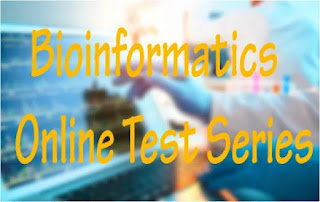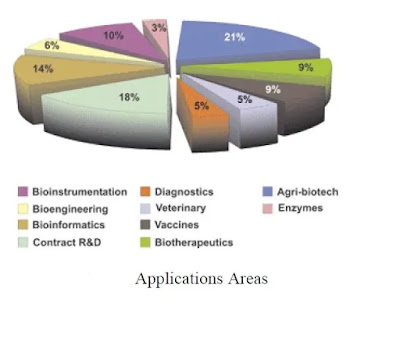Friday, October 30, 2020
Thursday, October 29, 2020
Saturday, May 30, 2020
How much salary did Bioinformatician get?

Students, who Studied Bioinformatics, wants to know "How much salary did Bioinformatician get?". Also Bioinformatics professional can get right value if they work in right place.
It creates awareness and curiosity in working in bioinformatics. Let us know more about it below.
Salaries of Bioinformaticians in Past were as follow:
Salary of a Bioinformatician in India:
- Starting with a package of Rs 12,000 to Rs 15,000, you can expect Rs 20,000 with a couple of years of experience under your belt.
-In fact, the acute shortage of experts in the field has given rise to active poaching of scientists from premier research institutions.
-The going price for bioinformaticians with a year’s experience is upwards of Rs 50,000 per month.
Salary of a Bioinformatician in Abroad Countries:
Starting salaries in the USA range between $60,000 and $ 90,000 for professionals with a couple of years of experience.
Average salaries in biotech and pharmaceutical companies are as follows:
Clinical Research:
* Associate: $51,500
*Senior associate: $65,000
*Manager: $85,000
*Clinical research physician: $90,000200,000
*Senior laboratory technician: $34,000
*Junior laboratory technician: $21,715
Biostatistics:
*MS entry-level: $74,500
*PhD entry-level: $110,000
Regulatory Affairs:
*Associate: $52,000
*Senior associate: $76,000
Scientist:
In 1999, average earnings of scientists employed by the federal government were:
*General biologists: $56,000
*Microbiologists: $62,600
*Physiologists: $71,300
*Geneticists: $68,200
Persons with Degrees in biological science:
Average salary offers in 1999 for those with degrees in biological science were:
*BS: $29,000
*MS: $34,450
*PhD: $45,700
Median earnings in industries employing the greatest number of biological and medical scientists in 1997 were:
*Federal government: $48,600
*Pharmaceuticals: $46,300
*Research and testing services: $40,800
*State government: $38,000
This data motivates students of bioinformatics to work creatively with smart hard-work to gain high package in bioinformatics industry.
Friday, May 29, 2020
Problems of developing bioinformatics sector in india
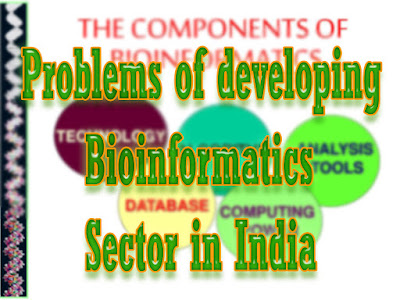
Developing skills of bioinformatics are major problems in bioinformatics trainee, students, or students/working professionals with pure biology background.
Problems of developing bioinformatics sector in India are:
- The major issue for India is its transition from a recognized global leader in software development to areas of real strength upon which it can capitalize in the biosciences.
- The identifiable areas are in computation biology and bioinformatics, where a substantial level of development skills are required to develop custom applications to knot together and integrate disparate databases (usually from several global locations), simulations, molecular images, docking programs etc.
- The industry people, meanwhile, say that the mushrooming of bioinformatic institutes is creating a problem of finding talented and trained individuals in this industry.
- While many of them have a superficial knowledge and a certificate, India lacks true professionals in this area.
- Most people, who opt for bioinformatics are from the life sciences areas that do not have exposure to the IT side of bioinformatics, which is very important.
- Another issue is that some companies face shortage of funds and infrastructure.
- The turn around time for an average biotech industry to break even would be around three to five years.
- Most of the venture capitals and other sources of funding would not be very supportive, especially if the company is not part of a larger group venture.
- It would help if the government would take an active role in building infrastructure and funding small and medium entrepreneurs.
Tuesday, May 12, 2020
Top 20 Applications of Bioinformatics
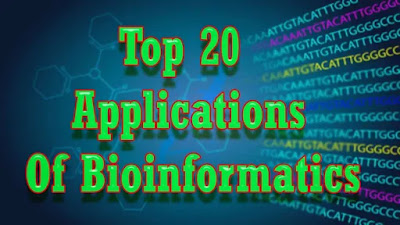 These are "Top 20 Applications of Bioinformatics ".
These are "Top 20 Applications of Bioinformatics ".These application areas of bioinformatics are very vast to explore to find solution of biological problems, generating curiosity for bioinformatics professionals and computational biologists.
Top 20 Applications of Bioinformatics are:
1. Molecular medicine:
- The human genome will have profound effects on the fields of biomedical research and clinical medicine.- Every disease has a genetic component. This may be inherited (as is the case with an estimated 3000-4000 hereditary disease including Cystic Fibrosis and Huntingtons disease) or a result of the body's response to an environmental stress which causes alterations in the genome (e.g. cancers, heart disease, diabetes.).
- The completion of the human genome means that we can search for the genes directly associated with different diseases and begin to understand the molecular basis of these diseases more clearly.
-This new knowledge of the molecular mechanisms of disease will enable better treatments, cures and even preventative tests to be developed.
2. Personalised medicine:
- Clinical medicine will become more personalised with the development of the field of pharmacogenomics.- This is the study of how an individual's genetic inheritance affects the body's response to drugs.
- At present, some drugs fail to make it to the market because a small percentage of the clinical patient population show adverse affects to a drug due to sequence variants in their DNA. As a result, potentially life saving drugs never makes it to the marketplace.
- Today, doctors have to use trial and error to find the best drug to treat a particular patient as those with the same clinical symptoms can show a wide range of responses to the same treatment.
- In the future, doctors will be able to analyse a patient's genetic profile and prescribe the best available drug therapy and dosage from the beginning.
3. Preventative medicine:
- With the specific details of the genetic mechanisms of diseases being unraveled, the development of diagnostic tests to measure a persons susceptibility to different diseases may become a distinct reality.- Preventative actions such as change of lifestyle or having treatment at the earliest possible stages when they are more likely to be successful, could result in huge advances in our struggle to conquer disease.
4. Gene therapy:
- In the not too distant future, the potential for using genes themselves to treat disease may become a reality.- Gene therapy is the approach used to treat, cure or even prevent disease by changing the expression of a person’s genes.
- Currently, this field is in its infantile stage with clinical trials for many different types of cancer and other diseases ongoing.
5. Drug development:
- At present all drugs on the market target only about 500 proteins.- With an improved understanding of disease mechanisms and using computational tools to identify and validate new drug targets, more specific medicines that act on the cause, not merely the symptoms, of the disease can be developed.
- These highly specific drugs promise to have fewer side effects than many of today's medicines.
6. Microbial genome applications:
- Microorganisms are ubiquitous, that is they are found everywhere. They have been found surviving and thriving in extremes of heat, cold, radiation, salt, acidity and pressure.- They are present in the environment, our bodies, the air, food and water. Traditionally, use has been made of a variety of microbial properties in the baking, brewing and food industries.
- The arrival of the complete genome sequences and their potential to provide a greater insight into the microbial world and its capacities could have broad and far reaching implications for environment, health, energy and industrial applications.
- For these reasons, in 1994, the US Department of Energy (DOE) initiated the MGP (Microbial Genome Project) to sequence genomes of bacteria useful in energy production, environmental cleanup, industrial processing and toxic waste reduction.
- By studying the genetic material of these organisms, scientists can begin to understand these microbes at a very fundamental level and isolate the genes that give them their unique abilities to survive under extreme conditions.
7. Waste cleanup:
- Deinococcus radiodurans is known as the world's toughest bacteria and it is the most radiation resistant organism known.
- Scientists are interested in this organism because of its potential usefulness in cleaning up waste sites that contain radiation and toxic chemicals.
8. Climate change Studies:
- Increasing levels of carbon dioxide emission, mainly through the expanding use of fossil fuels for energy, are thought to contribute to global climate change. Recently, the DOE (Department of Energy, USA) launched a program to decrease atmospheric carbon dioxide levels.- One method of doing so is to study the genomes of microbes that use carbon dioxide as their sole carbon source.
9. Alternative energy sources:
- Scientists are studying the genome of the microbe Chlorobium tepidum which has an unusual capacity for generating energy from light10. Biotechnology:
- The archaeon Archaeoglobus fulgidus and the bacterium Thermotoga maritima have potential for practical applications in industry and government-funded environmental remediation.- These microorganisms thrive in water temperatures above the boiling point and therefore may provide the DOE, the Department of Defence, and private companies with heat-stable enzymes suitable for use in industrial processes.
- Other industrially useful microbes include, Corynebacterium glutamicum which is of high industrial interest as a research object because it is used by the chemical industry for the biotechnological production of the amino acid lysine.
- The substance is employed as a source of protein in animal nutrition. Lysine is one of the essential amino acids in animal nutrition.
- Biotechnologically produced lysine is added to feed concentrates as a source of protein, and is an alternative to soybeans or meat and bonemeal.
- Xanthomonas campestris pv. is grown commercially to produce the exopolysaccharide xanthan gum, which is used as a viscosifying and stabilising agent in many industries.
- Lactococcus lactis is one of the most important micro-organisms involved in the dairy industry, it is a non-pathogenic rod-shaped bacterium that is critical for manufacturing dairy products like buttermilk, yogurt and cheese.
- This bacterium, Lactococcus lactis ssp., is also used to prepare pickled vegetables, beer, wine, some bread and sausages and other fermented foods. Researchers anticipate that understanding the physiology and genetic make-up of this bacterium will prove invaluable for food manufacturers as well as the pharmaceutical industry, which is exploring the capacity of L. lactis to serve as a vehicle for delivering drugs.
11. Antibiotic resistance:
- Scientists have been examining the genome of Enterococcus faecalis-a leading cause of bacterial infection among hospital patients.- They have discovered a virulence region made up of a number of antibiotic-resistant genes that may contribute to the bacterium's transformation from a harmless gut bacteria to a menacing invader.
- The discovery of the region, known as a pathogenicity island, could provide useful markers for detecting pathogenic strains and help to establish controls to prevent the spread of infection in wards.
12. Forensic analysis of microbes:
- Scientists used their genomic tools to help distinguish between the strain of Bacillus anthryacis that was used in the summer of 2001 terrorist attack in Florida with that of closely related anthrax strains13. The reality of bioweapon creation:
- Scientists have recently built the virus poliomyelitis using entirely artificial means.- They did this using genomic data available on the Internet and materials from a mail-order chemical supply.
- The research was financed by the US Department of Defense as part of a biowarfare response program to prove to the world the reality of bioweapons. The researchers also hope their work will discourage officials from ever relaxing programs of immunisation.
- This project has been met with very mixed feelings
14. Evolutionary studies:
- The sequencing of genomes from all three domains of life, eukaryota, bacteria and archaea means that evolutionary studies can be performed in a quest to determine the tree of life and the last universal common ancestor.15. Crop improvement:
- Comparative genetics of the plant genomes has shown that the organisation of their genes has remained more conserved over evolutionary time than was previously believed.- These findings suggest that information obtained from the model crop systems can be used to suggest improvements to other food crops.
- At present the complete genomes of Arabidopsis thaliana (water cress) and Oryza sativa (rice) are available.
16. Insect resistance:
- Genes from Bacillus thuringiensis that can control a number of serious pests have been successfully transferred to cotton, maize and potatoes.- This new ability of the plants to resist insect attack means that the amount of insecticides being used can be reduced and hence the nutritional quality of the crops is increased.
17. Improve nutritional quality:
- Scientists have recently succeeded in transferring genes into rice to increase levels of Vitamin A, iron and other micronutrients.- This work could have a profound impact in reducing occurrences of blindness and anaemia caused by deficiencies in Vitamin A and iron respectively.
- Scientists have inserted a gene from yeast into the tomato, and the result is a plant whose fruit stays longer on the vine and has an extended shelf life.
18. Development of Drought resistance varieties:
-Progress has been made in developing cereal varieties that have a greater tolerance for soil alkalinity, free aluminium and iron toxicities.-These varieties will allow agriculture to succeed in poorer soil areas, thus adding more land to the global production base.
-Research is also in progress to produce crop varieties capable of tolerating reduced water conditions.
19. Vetinary Science:
Sequencing projects of many farm animals including cows, pigs and sheep are now well under way in the hope that a better understanding of the biology of these organisms will have huge impacts for improving the production and health of livestock and ultimately have benefits for human nutrition.20. Comparative Studies:
- Analysing and comparing the genetic material of different species is an important method for studying the functions of genes, the mechanisms of inherited diseases and species evolution.- Bioinformatics tools can be used to make comparisons between the numbers, locations and biochemical functions of genes in different organisms.
- Organisms that are suitable for use in experimental research are termed model organisms.
- They have a number of properties that make them ideal for research purposes including short life spans, rapid reproduction, being easy to handle, inexpensive and they can be manipulated at the genetic level.
An example of a human model organism is the mouse. Mouse and human are very closely related (>98%) and for the most part we see a one to one correspondence between genes in the two species.
- Manipulation of the mouse at the molecular level and genome comparisons between the two species can and is revealing detailed information on the functions of human genes, the evolutionary relationship between the two species and the molecular mechanisms of many human diseases.
7 Bioinformatics Projects
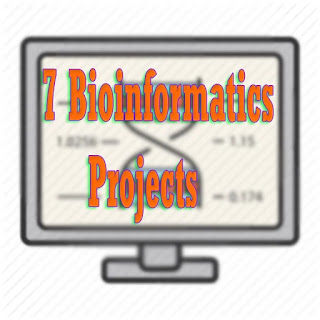
These are 7 Bioinformatics Projects being developed continuously by developers
to increase working efficiency of Bioinformatics Professionals and computational Biologist.
7 Bioinformatics Projects are:
1. BioJava:
The BioJava Project is dedicated to providing Java tools for processing biological data which includes objects for manipulating sequences, dynamic programming, file parsers, simple statistical routines, etc.2. BioPerl:
The BioPerl project is an international association of developers of Perl tools for bioinformatics and provides an online resource for modules, scripts and web links for developers of Perl-based software.3. BioXML:
A part of the BioPerl project, this is a resource to gather XML documentation, DTDs and XML aware tools for biology in one location.4. Biocorba:
- Interface objects have facilitated interoperability between bioperl and other perl packages such as Ensembl and the Annotation Workbench.- However, interoperability between bioperl and packages written in other languages requires additional support software.
- CORBA is one such framework for interlanguage support, and the biocorba project is currently implementing a CORBA interface for bioperl.
- With biocorba, objects written within bioperl will be able to communicate with objects written in biopython and biojava (see the next subsection).
- For more information, see the biocorba project website.
- The Bioperl BioCORBA server and client bindings are available in the bioperl-corba-server and bioperl-corba-client bioperl CVS repositories respecitively.
5. Ensembl:
- Ensembl is an ambitious automated-genome-annotation project at EBI.- Much of Ensembl\'s code is based on bioperl, and Ensembl developers, in turn, have contributed significant pieces of code to bioperl.
- In particular, the bioperl code for automated sequence annotation has been largely contributed by Ensembl developers.
- Describing Ensembl and its capabilities is far beyond the scope of this tutorial The interested reader is referred to the Ensembl website.
6. bioperl-db:
- Bioperl-db is a relatively new project intended to transfer some of Ensembl's capability of integrating bioperl syntax with a standalone Mysql database (http://www.mysql.com/) to the bioperl code-base.- More details on bioperl-db can be found in the bioperl-db CVS directory at http://cvs.bioperl.org/cgi-bin/viewcvs/viewcvs.cgi/bioperl-db/?cvsroot=bioperl. It is worth mentioning that most of the bioperl objects mentioned above map directly to tables in the bioperl-db schema.
- Therefore object data such as sequences, their features, and annotations can be easily loaded into the databases, as in $loader->store($newid,$seqobj).
- Similarly one can query the database in a variety of ways and retrieve arrays of Seq objects.
- See biodatabases.pod, Bio::DB::SQL::SeqAdaptor, Bio::DB::SQL::QueryConstraint, and Bio::DB::SQL::BioQuery for examples.
7. Biopython and biojava:
- Biopython and biojava are open source projects with very similar goals to bioperl.- However their code is implemented in python and java, respectively.
- With the development of interface objects and biocorba, it is possible to write java or python objects which can be accessed by a bioperl script, or to call bioperl objects from java or python code.
- Since biopython and biojava are more recent projects than bioperl, most effort to date has been to port bioperl functionality to biopython and biojava rather than the other way around.
- However, in the future, some bioinformatics tasks may prove to be more effectively implemented in java or python in which case being able to call them from within bioperl will become more important.
- For more information, go to the biojava http://biojava.org/ and biopython http://biopython.org/ websites.
Subscribe to:
Posts (Atom)

